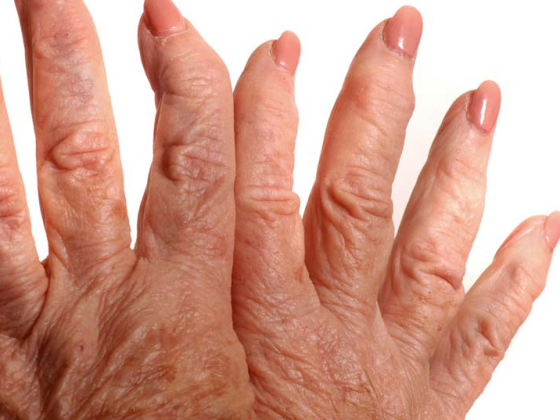In patients with chronic spontaneous urticaria, high baseline serum FcεRI levels may be a predictor of response to omalizumab treatment. This is the conclusion of a study presented at the annual meeting of the Working Group for Dermatological Research. These results are very interesting and clinically relevant.
Chronic spontaneous urticaria is characterized by itchy wheals, angioedema, or both. The treatment goal is to achieve complete symptom control. Current guidelines recommend the use of non-sedative antihistamines as first- and second-line treatment up to 4-6-fold up-dose. For the numerous patients in whom this therapeutic option is not sufficient, anti-IgE treatment with the monoclonal antibody omalizumab (Xolair®) is the therapy of choice [1]. Although the majority of patients benefit from this treatment option, there are always cases with a lack of response to therapy. To find out more about this, it is worthwhile to take a look at the pathophysiological basis.
Is there a type I allergy or type IIb autoimmunity?
Mast cell activation is a central pathophysiologic factor in chronic spontaneous urticaria. According to current knowledge, two different autoimmune mechanisms can be differentiated that result in mast cell activation. In the more common autoallergic form (type I allergy), patients develop IgE antibodies, whereas in autoimmune type IIb, IgG and IgM autoantibodies are formed, directed for example against the IgE receptor FcεRI, which subsequently leads to activation of mast cells [1]. The presence of such autoantibodies can be detected by a basophil histamine release assay (BHRA) [2]. With a positive BHRA result (~20% of all patients), on the one hand, the probability for a more severe and more persistent course is higher, on the other hand, this patient subpopulation shows a significantly worse therapy response to the anti-IgE antibody omalizumab [3].
|
Biologic therapy for chronic spontaneous urticaria Currently, omalizumab (Xolair®) is the only biologic approved for this indication in Switzerland [5]. Anti-IgE monoclonal antibody is indicated for adults and adolescents 12 years of age and older with chronic spontaneous urticaria if H1 antihistamine therapy fails to achieve adequate symptom control. Omalizumab binds to IgE, preventing IgE from binding to the Fc-RI (high-affinity IgE receptor) on basophils and mast cells, thereby reducing the amount of free IgE. Currently, other biologics are being investigated for the treatment of chronic spontaneous urticaria [1]. In advanced stages of clinical testing (phase III) are ligelizumab, also an anti-IgE antibody, and dupilumab, a monoclonal antibody directed against IL4 and IL13. Furthermore, MRGPRX2-triggered activation of mast cells will be investigated as a potential target for new active compounds. |
Study to evaluate the therapeutic response to omalizumab
Given that elevated serum levels of soluble FcεRI (sFcεRI; >2 ng/mL) are associated with IgE/FcεRI-mediated mast cell activation, a research team including the Department of Dermatology, Venereology and Allergology at Charité Universitätsmedizin Berlin, Germany, conducted a study to evaluate sFcεRI as a biomarker for treatment response to omalizumab [4]. Serum samples from 67 patients with chronic spontaneous urticaria were analyzed for sFcεRI levels by ELISA and correlated with clinical data. Thirty-one healthy individuals served as the control group. Patients with chronic spontaneous urticaria received standard omalizumab treatment (300 mg s.c., every 4 weeks). Treatment response was assessed by the Urticaria Control Test (UCT) at 4 and 8 weeks after the first omalizumab injection. Patients with a UCT ≥12 were defined as responders.
Baseline serum levels of sFcεRI were found to be significantly higher in omalizumab-treated patients than in healthy controls (mean SEM* values: 5.01 vs. 1.30 ng/mL) and correlated with total IgE levels (r=0.36, p<0.01). The proportion of patients who showed a response to omalizumab treatment was 63% at 4 weeks and 68% at 8 weeks. Those who responded to therapy as early as week 4 had higher baseline sFcεRI levels of approximately 6.52 ng/mL compared to 2.91 ng/mL in non-responders (p=0.03). Baseline sFcεRI levels were also found to be higher in those who showed a response at week 8 compared to non-responders, although this difference was not significant with values of approximately 6.32 ng/mL versus 2.91 ng/mL (p=0.067). Baseline sFcεRI levels >2 ng/mL were associated with a 60% (p=0.049) and 50% (p=0.037) higher response rate at week 4 and week 8, respectively, compared to those patients with baseline levels <2 ng/mL.
* SEM (Standard errof of the mean) = Standard error of the mean value
Conclusion
The study authors concluded that high baseline FcεRI serum levels in chronic spontaneous urticaria may be a predictor of treatment response to omalizumab treatment, although this was a rather small study population [4].
Congress: Working Group for Dermatological Research 2021
Literature:
- Metz M, Maurer M: Use of biologics in chronic spontaneous urticaria – beyond omalizumab therapy? Allergology Select 2021; 5: 89-95.
- Chang TW, et al: The potential pharmacologic mechanisms of omalizumab in patients with chronic spontaneous urticaria. J Allergy Clin Immunol 2015; 135: 337-342.
- Gericke J, et al: Serum autoreactivity predicts time to response to omalizumab therapy in chronic spontaneous urticaria. J Allergy Clin Immunol 2017; 139: 1059-1061.e1.
- Moino-Romero S, et al: Soluble FcεRI is a potential biomarker for therapeutic response to omalizumab in patients with chronic spontaneous urticaria. P070, ADF Annual Meeting 04.03.-06.3.2021.
- Drug Information, www.swissmedicinfo.ch (last accessed Jun. 18, 2021).
DERMATOLOGIE PRAXIS 2021; 31(4): 20 (published 8/19-21, ahead of print).











